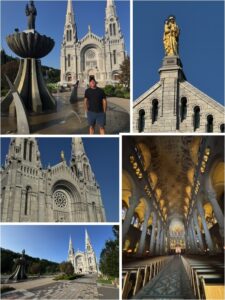We were vacationing in Quebec City for about three days when it finally hit me:
This is where my mother’s side of the family lived not that long ago.
I should’ve known this, since I knew it, but it simply never occurred to me at the beginning of this trip. Then I found myself eating meat pie and baked beans for breakfast and shepherd’s pie for dinner. I heard the people of Quebec speaking Québécois and sounding just like my grandmother, grandfather, and great-grandmother.
They even look like my grandparents.
Of course.
Also, duh.
This is the land of my people.
Happily, in the midst of the trip, after reading a post about our wedding song being played in Montreal, my Aunt Diane — sister of my mother — reached out to catch me up on some family history, including this remarkable story:
“You may not know that your grandfather made a plea, when your grandmother was dying of cancer in 1962 (and given 6 months to live), that if she were cured, they would visit Quebec City and the shrine of St. Anne every year for the rest of their lives. She recovered, and they went to Quebec City and St. Anne’s every year until my dad could no longer drive there.”
I had no idea.
I had never heard this story before, but after visiting the Montmorency Falls and Ile d’Orleans (where my family’s roots can be traced back to 1666), we drove up the river to visit the shrine of St. Anne, mother to Mary, who was mother to Jesus.
I expected to find a small church and an even smaller shrine, perhaps in a town where one of my ancestors once lived, but instead, we found the most beautiful, majestic church we’ve ever seen.
“One of the most beautiful buildings I have ever seen,” Elysha said.
It was unspeakably magnificent and enormous beyond measure, making the Notre Dame Basilica in Montreal pale in comparison. Filled with elaborate mosaics, stained glass windows, ornate floors, ornamental ceilings, and so much more.
It would’ve been worth the trip to see the church even if I hadn’t known my grandmother and grandfather made an annual pilgrimage to this place for more than thirty years.
I wondered as we drove to the church:
What makes two people decide to travel hundreds of miles every summer to visit a church? I know my grandfather made a promise to God, but he also had six kids and a full-time job.
It would’ve been understandable to miss a year or two.
Or six.
What made a couple undertake this pilgrimage year after year after year?
Now I know.
As Elysha said:
“You could spend a lifetime just studying the art in this place and never finish.”
But the best part for me was walking through the enormous doorway at the front of the church, knowing that my grandparents, who passed away almost three decades ago, once walked through this same portal again and again and again.
I tried to imagine them — younger, more vibrant, and filled with gratitude and appreciation — entering this building again and again and being overwhelmed by its beauty each time, just as I was upon entering the first time.
Connecting the past with the present is something I constantly seek to do:
Live in the moment while relentlessly trying to understand how this moment is the result of so many moments that came before it.
While visiting St. Anne’s Church, I had a chance to do just that:
Bring the past and the present together. Link them in a singular moment of awe and wonder. Walk in my grandparents’ footsteps, and for a moment, see the world as they did.
To think I almost missed it.
We need to tell our stories:
To our friends, our colleagues, our spouses, our children, and yes, our grandchildren.










